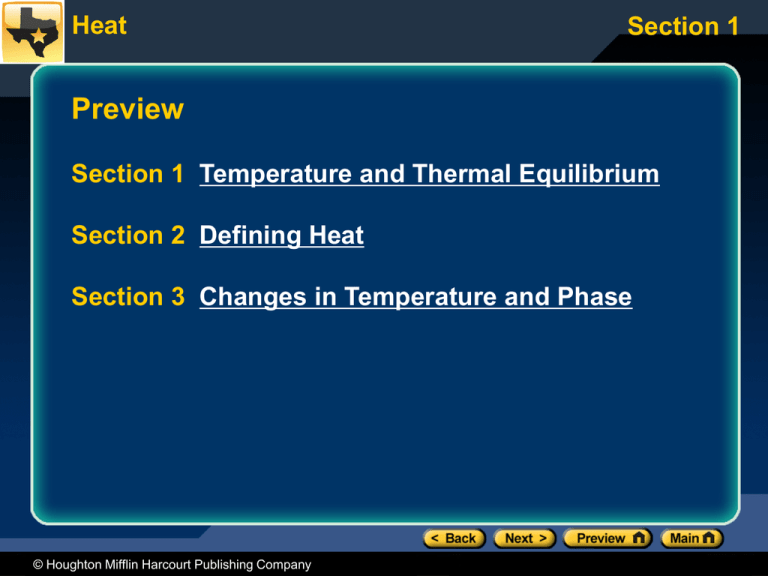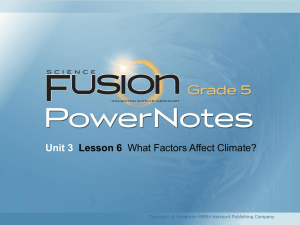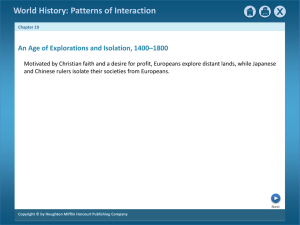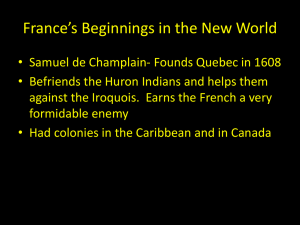Heat Notes PPT
advertisement

Heat Section 1 Preview Section 1 Temperature and Thermal Equilibrium Section 2 Defining Heat Section 3 Changes in Temperature and Phase © Houghton Mifflin Harcourt Publishing Company Heat TEKS Section 1 The student is expected to: 6E describe how the macroscopic properties of a thermodynamic system such as temperature, specific heat, and pressure are related to the molecular level of matter, including kinetic or potential energy of atoms © Houghton Mifflin Harcourt Publishing Company Heat Section 1 What do you think? • Suppose you have two cups of water. One is hot and the other is cold. – How is the cold water different from the hot water? • Describe the motion of the molecules in each. – What changes would occur if the hot water was changed into steam? • What are the common scales used to measure temperature? – When is each scale generally used? – All scales use degrees to measure temperature. Which scale has the largest degrees? Explain. © Houghton Mifflin Harcourt Publishing Company Heat Section 1 Temperature • Temperature measures the average kinetic energy of the particles. – Average speed is used because all particles do not have the same speed, and speeds change as the particles collide. • Internal energy is the energy a substance has due to the motion of the particles (kinetic energy) and the position of the particles (potential energy). © Houghton Mifflin Harcourt Publishing Company Heat Section 1 Forms of Internal Energy Click below to watch the Visual Concept. Visual Concept © Houghton Mifflin Harcourt Publishing Company Heat Section 1 Temperature • Do thermometers change the temperature of the substance being measured? – If so, how? – How can you minimize the problem? • Temperature must be measured when thermal equilibrium is reached. • Always read a thermometer after it has stopped rising or falling. – At this point, equilibrium has been reached between the thermometer and the substance. © Houghton Mifflin Harcourt Publishing Company Heat Section 1 Thermal Expansion Click below to watch the Visual Concept. Visual Concept © Houghton Mifflin Harcourt Publishing Company Heat Section 1 Thermometers • The expansion of mercury changes the reading in this thermometer. • How does such a small change in the volume of the mercury (see circled segments) result in such a large rise inside the thermometer? © Houghton Mifflin Harcourt Publishing Company Heat Section 1 Thermometers • Calibration depends on fixed temperatures. • Three common temperature scales used: – Fahrenheit for weather and medicine (U.S.) – Celsius for work in science – Kelvin or absolute for many scientific laws © Houghton Mifflin Harcourt Publishing Company Heat Comparison of Temperature Scales © Houghton Mifflin Harcourt Publishing Company Section 1 Heat The Absolute Temperature Scale • What is meant by absolute zero? – Absolute zero = 0 K • Suppose the pressure and temperature of a gas are plotted as shown, and the graph is extrapolated to 0 K. What does this suggest about P at absolute zero (-273.15°C or 0 K)? – P = 0 at absolute zero © Houghton Mifflin Harcourt Publishing Company Section 1 Heat Temperature Conversions © Houghton Mifflin Harcourt Publishing Company Section 1 Heat Section 1 Classroom Practice Problems • One day it was -40°C at the top of Mont Blanc and -40°F at the top of Mount Whitney. Which place was colder? – Answer: Neither (-40°C = -40°F) • What is the Fahrenheit temperature equivalent to absolute zero? – Answer: -459.67°F • What is the Celsius temperature on a hot summer day when the temperature is 100. °F? – Answer: 37.8°C © Houghton Mifflin Harcourt Publishing Company Heat Section 1 Now what do you think? • Suppose you have two cups of water. One is hot and the other is cold. – How is the cold water different from the hot water? • Describe the motion of the molecules in each. – What changes would occur if the hot water was changed into steam? • What are the common scales used to measure temperature? – When is each scale generally used? – All scales use degrees to measure temperature. Which scale has the largest degrees? Explain. © Houghton Mifflin Harcourt Publishing Company Heat TEKS Section 2 The student is expected to: 6E describe how the macroscopic properties of a thermodynamic system such as temperature, specific heat, and pressure are related to the molecular level of matter, including kinetic or potential energy of atoms 6F contrast and give examples of different processes of thermal energy transfer, including conduction, convection, and radiation © Houghton Mifflin Harcourt Publishing Company Heat Section 2 What do you think? • Internal energy is the energy due to the kinetic and potential energy of the particles. – Does the ice water or an equal quantity of hot chocolate have greater internal energy? Why? – Which has more internal energy, a gallon of cold water or a drop of hot chocolate? – How will the internal energy of the water and hot chocolate change over time? • How will this change occur? © Houghton Mifflin Harcourt Publishing Company Heat Section 2 Internal Energy and Heat • Internal Energy (U) is the energy contained within the particles of a substance. • Heat (Q) is the internal energy transferred between objects. – Heat always moves from a higher-temperature object to a lower-temperature object. – The rate of transfer depends on the difference in temperature. • The greater the temperature difference, the greater the rate of energy transfer (if other factors are equal). © Houghton Mifflin Harcourt Publishing Company Heat Section 2 Internal Energy and Heat • Which way does heat flow if you place a warm canned beverage in cold water? • How does this occur, on a molecular level? © Houghton Mifflin Harcourt Publishing Company Heat Section 2 Temperature and Heat Click below to watch the Visual Concept. Visual Concept © Houghton Mifflin Harcourt Publishing Company Heat Heat has Units of Energy (joules) © Houghton Mifflin Harcourt Publishing Company Section 2 Heat Section 2 Heat Transfer • In what three ways can internal energy be transferred from a hot object to a colder object? – Conduction is the transfer of heat through a substance by molecule to molecule contact. • Metals are good conductors. • Styrofoam is a good insulator. – Convection is the transfer of energy by the movement of a fluid. • Hot air in a room rises and cold air moves in to replace it. – Radiation is the transfer of energy by electromagnetic waves. • No matter is transferred, only energy. © Houghton Mifflin Harcourt Publishing Company Heat Section 2 Comparing Convection, Conduction, and Radiation Click below to watch the Visual Concept. Visual Concept © Houghton Mifflin Harcourt Publishing Company Heat Section 2 Heat and Work • Work can be changed into internal energy (U). – Rub your hands together and you’ll feel the increase in internal energy produced by your work. – Pull a nail from a piece of wood and the nail is hot. • Mechanical energy (PE + KE) is conserved when there is no friction. • Total energy, including internal energy, is always conserved. © Houghton Mifflin Harcourt Publishing Company Heat Section 2 Energy Conservation • Any loss of one type is balanced by a gain in the other types of energy. • Predict the sign (+, -, or 0) for the change in each quantity when: – A child slides down a plastic playground slide – A car applies the brakes to stop on a level road © Houghton Mifflin Harcourt Publishing Company Heat Section 2 Now what do you think? – Does the ice water or an equal quantity of hot chocolate have greater internal energy? Why? – Which has more internal energy, a gallon of cold water or a drop of hot chocolate? – How will the internal energy of the water and hot chocolate change over time? • How will this change occur? © Houghton Mifflin Harcourt Publishing Company Heat TEKS Section 3 The student is expected to: 6E describe how the macroscopic properties of a thermodynamic system such as temperature, specific heat, and pressure are related to the molecular level of matter, including kinetic or potential energy of atoms © Houghton Mifflin Harcourt Publishing Company Heat Section 3 What do you think? • What property of water makes it so useful as a coolant in automobiles, nuclear reactors, and other machinery? • How does it differ from other liquids regarding its ability to cool substances? • Why do you feel cool when getting out of a warm swimming pool on a hot day? • How do you feel if it is windy out? Why? • How do you feel if it is an indoor pool? Why? © Houghton Mifflin Harcourt Publishing Company Heat Section 3 Specific Heat Capacity • Specifc heat capacity (cp) measures the amount of heat required to raise the temperature by 1°C for 1 kg of a substance. – It is different for every substance. • SI Units: J/kg•°C • Alternate form of this equation: Q = cpmT © Houghton Mifflin Harcourt Publishing Company Heat Section 3 • Suppose each metal shown above absorbs 100 J of energy. – Which will show the greatest increase in temperature? the least? – How does water compare to iron with regard to heat capacity? © Houghton Mifflin Harcourt Publishing Company Heat Calorimetry • Calorimetry is a problemsolving approach to heat transfer problems. – Conservation of energy – Qgained = -Qlost • A calorimeter is an insulated cup with water used for the experiment. – Ignore heat gained or lost by the cup, as it is small. © Houghton Mifflin Harcourt Publishing Company Section 3 Heat Section 3 Classroom Practice Problem • In a student’s experiment, a 0.125 kg metal ball is placed in a calorimeter filled with 0.150 kg of water at 21.0°C. The initial temperature of the ball is 98.5°C. After reaching equilibrium, the temperature is 27.3°C. Find the specific heat capacity of the metal and use the table to determine the type of metal. – Answer: 444 J/kg•°C , very close to iron © Houghton Mifflin Harcourt Publishing Company Heat Section 3 Classroom Practice Problem • A bathtub has 20.0 kg of water at 60.0°C and the bather wants the temperature to be 30.0°C. How much 20.0°C water must be added to the bath water to achieve the desired temperature? – Answer : 60.0 kg © Houghton Mifflin Harcourt Publishing Company Heat Section 3 Latent Heat • Latent heat is heat gained or lost during phase changes. – When substances melt, freeze, boil, condense, or sublime, the temperature does not change during the phase change. – Heat absorbed changes the potential energy of the particles. © Houghton Mifflin Harcourt Publishing Company Heat Section 3 Latent Heat Click below to watch the Visual Concept. Visual Concept © Houghton Mifflin Harcourt Publishing Company Heat Section 3 Latent Heat • Heat of fusion (Lf) is the heat required to melt 1 kg of a substance. – Also equals the heat released when 1 kg freezes – Which graph segment represents this? • Heat of vaporization (Lv) is the heat required to change 1 kg of a substance from a liquid to a gas. – Which graph segment represents this? © Houghton Mifflin Harcourt Publishing Company Heat Section 3 Latent Heats of Fusion and Vaporization © Houghton Mifflin Harcourt Publishing Company Heat Section 3 Now what do you think? • What property of water makes it so useful as a coolant in automobiles, nuclear reactors and other machinery? • How does it differ from other liquids regarding its ability to cool substances? • Why do you feel cool when getting out of a warm swimming pool on a hot day? • How do you feel if it is windy out? Why? • How do you feel if it is an indoor pool? Why? © Houghton Mifflin Harcourt Publishing Company








